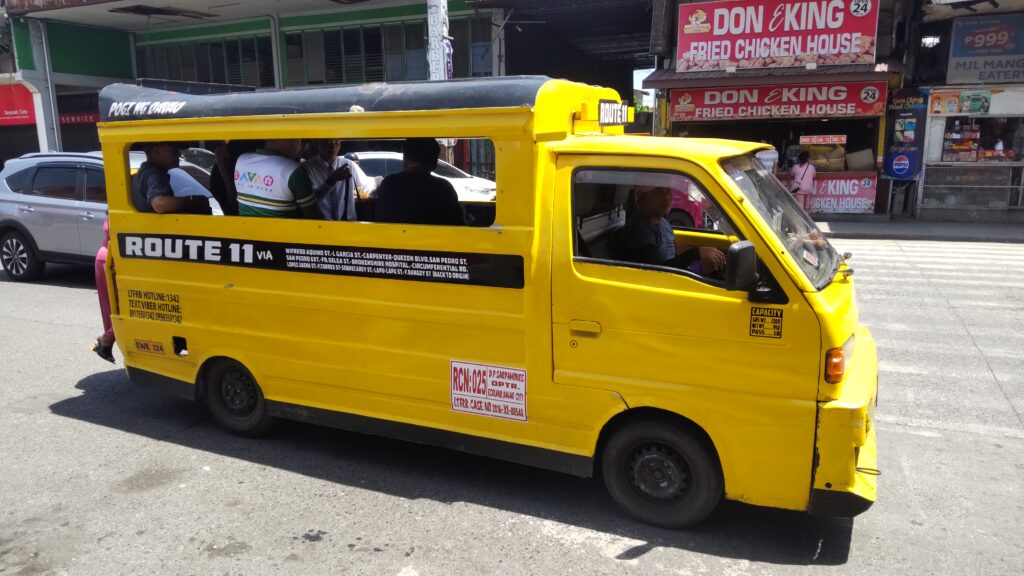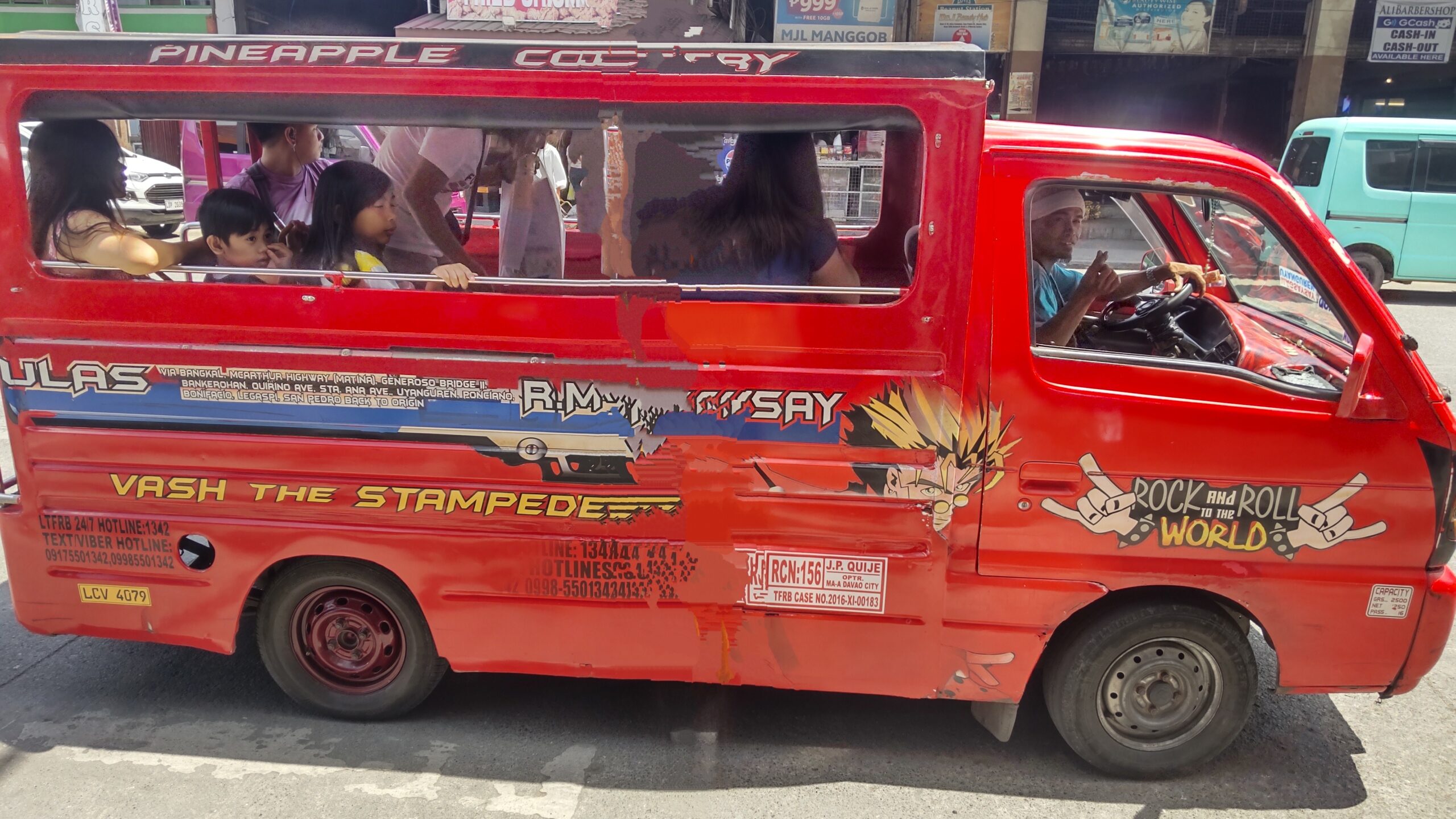While the riding experience in Davao is largely similar to Manila, there have been rumors about the discontinuation of Davao’s jeepneys in 2024, and I’ve investigated the truth behind these claims.
Table of Contents
- Jeepneys in Davao
- Characteristics of Jeepneys
- How to Ride a Jeepney
- Important Notes When Riding a Jeepney
- The Charm of Jeepneys
- Rumors of Davao Jeepney Discontinuation
- Past and Present Situation
- Why Did the Discontinuation Rumors Spread?
- Future Outlook
- Conclusion
Jeepneys in Davao
Jeepneys can be found all over the Philippines, so much of the information will be similar to what I covered in the Manila edition. Let’s briefly re-examine what jeepneys are.
Characteristics of Jeepneys
- Colorful Appearance: Each jeepney is vividly decorated, reflecting the owner’s individuality. Designs vary widely, from floral patterns to anime characters and landscapes.
- Modified Jeeps: They are built by modifying surplus U.S. military vehicles, with shapes and sizes differing by model.
- Diverse Routes: Each jeepney operates on a fixed route, and you may need to transfer to reach your destination.
- Local Atmosphere: Riding a jeepney offers a valuable opportunity to interact with local people.
How to Ride a Jeepney

- Finding a Stop: Jeepneys don’t have fixed stops; you can flag one down anywhere on the street. There are also spots where they stop for a while; here, attendants might be waiting to help guide passengers. If you’re unsure which jeepney to take, you can ask these attendants for directions.
- Route Numbers and Destination Displays: Davao jeepneys display either a route number or a destination name on their body. Route numbers are easy to understand for both inbound and outbound journeys, but for destination names, it’s best to confirm with someone before boarding if you’re not familiar.
- Stating Your Destination: Inform the driver or a passenger inside of your destination. Speaking in Tagalog (Cebuano) or English will make it smoother.
- Paying the Fare: For city travel, the fare is usually fixed, so pay the driver before you get off. It’s usually less than 20 pesos, so it’s best to hand over the exact coin amount. The fare is usually written above the driver’s seat; it might be small, so if you’re unsure, ask the driver or another passenger. If your seat is too far back to reach the driver, just hold out your money, and other passengers will pass it forward. Change will also be relayed back to you.
- Exiting: When you reach your destination, inform the driver or another passenger that you wish to alight. Alternatively, you can tap a metal part of the vehicle with a coin or knock on the roof to signal.
Important Notes When Riding a Jeepney
- Crowds: Jeepneys can get very crowded during rush hour, so allow ample time.
- Valuables: The vehicle can be crowded, so keep a close eye on your valuables.
- Boarding/Alighting: Safely board and alight before the vehicle starts moving or while it’s fully stopped.
The Charm of Jeepneys
- Local Experience: Enjoy interacting with the local people.
- Colorful Scenery: The vibrant jeepneys add color to Davao’s cityscape and are popular spots for photography.
- Affordable Transportation: It’s a much cheaper way to get around compared to taxis.
Rumors of Davao Jeepney Discontinuation
There has been a lot of conflicting information and confusion among people regarding the discontinuation of Davao’s jeepneys.
To be clear, there is currently no decision for jeepneys to be completely phased out.
Past and Present Situation
- Discontinuation Efforts: The Philippine government has been promoting the replacement of aging jeepneys with safer and more comfortable public transport. As part of this plan, there were moves to introduce new types of public buses in Davao City. These efforts led to rumors that jeepneys might be completely phased out.
- Current Situation: The government’s plan has shifted from completely phasing out jeepneys to modernizing them and replacing them with safer vehicles. In Davao City, support measures for jeepney drivers are being strengthened, and the transition to new vehicles is planned to occur in phases.
Why Did the Discontinuation Rumors Spread?
- Aging Issues: Philippine jeepneys have been aging, raising concerns about safety and environmental impact.
- Need for Modernization: The Philippine government viewed public transport improvement as essential for urban modernization.
- Introduction of New Transport Systems: The introduction of new types of public buses led to concerns that the role of jeepneys might diminish.
Future Outlook
- Jeepney Survival: Jeepneys are deeply rooted in the lives of the Filipino people and are more than just a mode of transport; they are part of the culture. Therefore, it is highly likely that a certain number of jeepneys will continue to exist rather than being completely phased out.
- Gradual Transition: It is expected that there will be coexistence with new types of public buses or a phased replacement.
- Driver Support: Support measures are planned for jeepney drivers, including assistance for transitioning to new professions or funding for purchasing new vehicles.
Conclusion
Davao’s jeepneys are expected to evolve into safer and more comfortable vehicles rather than being abolished. While they won’t completely disappear for now, their numbers may decrease. In reality, jeepneys travel not only on roads where buses can go but also on small residential streets. Also, with many vehicles on the same route, there’s rarely a long wait. It’s hard to imagine buses replicating this convenience.



